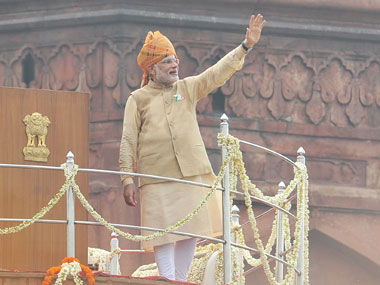Narendra Modi’s second Independence Day speech from the ramparts of Red Fort stood out for three things.
One, his focus on economic development continues. Casteism and communalism, he said, can only be wiped out through the amrit dhara (the nectar) of development.
Two, he seemed to have been tempered by one year in office. There was the almost apologetic line about last year’s speech – ‘I kept some ideas before you, I was new, I spoke about what I saw and what I felt.’
Three, and most important, the jibes about “suit-boot sarkar” and anti-farmer, anti-tribal policies had hit home; he was determined to correct the impression.
Hence, statements like the development pyramid will be strong only if the base, made up of the poor, is strong. Team India can move only on the strength of the poor. Who are the banks for, if not the poor? Garibon ki ameeri (the wealth of the poor). And so on and so forth.
Hence, the criticism about not respecting the rickshaw-puller, the auto driver, the newspaper vendor and the exhortation to make dignity of labour a part of our national character.
Hence also, the listing of what the government had done for the poor – mainly financial inclusion, social security. He reeled out statistics about the success of the Jan Dhan Yojana and other social security schemes. He spoke about the initiatives taken in agriculture – the more-crop-per-drop initiative, the compulsory neem coating of all urea to prevent diversion and improve productivity (though this was not something this government can take full credit for; 75 percent of urea was neem coated earlier).
But what of the future? His statements about what his government planned to do were good in parts and flawed in other parts.
The announcement about spending Rs 6,000 crore a year on development in mineral-rich tribal areas – a clear attempt to counter criticism about being anti-tribal for liberalising mining and land acquisition – is a welcome one. Modi clearly scores on this, especially when he pointed out that these areas make the rest of the nation wealthy but remain mired in backwardness.
The country needs to move away from the mindset that tribals want to live in the way they have always done, in pristine forest areas, bereft of the benefits of development. Better infrastructure in tribal areas is the need of the hour and is a far more sustainable way of helping them than the welfare-driven approach of the past. Better infrastructure is also needed to counter the left-wing menace in these areas.
The Naxalites won’t allow this to happen, they will step up attacks, but the government has to counter this and soldier on. How the government will implement this plan will be the key, since there will have to be a buy-in from state governments as well.
Where Modi slipped up was on the announcement of the renaming of the agriculture ministry as agriculture and farmer welfare ministry (Krishi evam Kisan Kalyan Mantralaya) and a new scheme, Kisan Kalyan Yojana.
If a name change was all that was required to change mindset and policy focus, then the renaming of the education ministry as human resource development ministry in the 1980s should have worked wonders. One needs to wait for the contours of the Kisan Kalyan Yojana to be unveiled but till then it appears to be another meaningless sop-driven scheme that one hoped the Modi government would avoid.
Both these announcements appear extremely defensive and out of sync with the understanding that Modi appeared to have of the reasons for agricultural stress in his speech – agricultural infrastructure, falling landholding sizes, power, irrigation. Pity, also, that he said nothing about freeing agriculture from the shackles of the government – it still remains the largest regulated private sector activity.
On the face of it, setting a 1,000-day target (a little short of three years) for electrification of 18,500 un-electrified villages is a great announcement. But putting up one electric pole in a village or even ensuring a connection in every village home will not work, with not enough attention being paid to regular electricity supply and making the exercise viable for state-run distribution companies (discoms).
Electrification of villages has been done earlier but without these problems being tackled, what has resulted is de-electrification of villages. States too have to be taken on board to improve the financial health of the state electricity boards (SEBs) – that’s not only a huge challenge but also a very complicated one.
The aspirational and empowering Modi was back in action when he spoke about encouraging start-ups and entrepreneurship. There should be no block or district without a start-up, he said. Some critics see this as moving away from a jobs focus to a self-employment focus, but there is nothing wrong with this.
But it is slightly worrying when he exhorts banks to get each of their 1.25 lakh branches to resolve to finance start-up ventures to at least one adivasi or dalit youth. Creating 1.25 lakh entrepreneurs is a wonderful dream and more empowering than job reservations for scheduled castes and scheduled tribes. But there is a danger that this could result in pressure to meet targets, leading to unviable projects being financed and creating another source of stress for banks.
Will this be worse than stress created by lending to big business? That is not the point. The fact that banks have lent to bad projects of big business should not become a justification to lend to bad projects by start-ups. Yes, banks should be encouraged to lend to start-up ventures, but they should not be pressured to do so and adequate safeguards need to be put in place.
But financing is not the only hurdle to start-ups (though it is an important one). There are still too many regulatory hurdles to starting a business, many of which are at the state and local level. What was missing from Modi’s speech was a reference to this.
His government has done quite a bit in easing the business scenario and a lot still remains to be done. His silence on this was perplexing. Perhaps he wanted to play down the pro-industry image that his detractors keep playing up. But ease of doing business is not about big business alone; it affects small entrepreneurs much more.
It would have been better if Modi been more combative on this than in defending the draconian black money law and labelling all opposition to it as coming from those benefiting from black money.
Well, he can’t get everything right all the time. And, hey, this is only a speech. Let’s wait for action.



